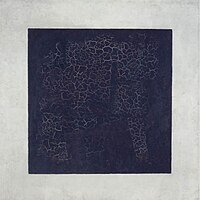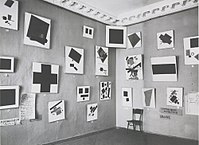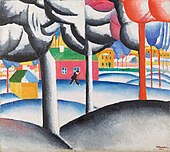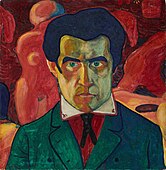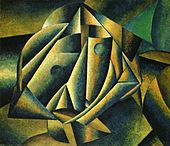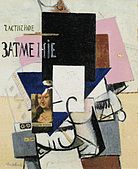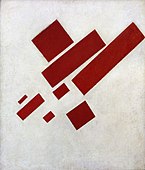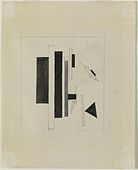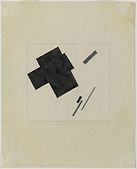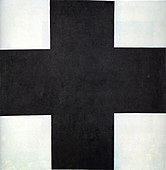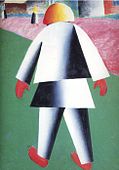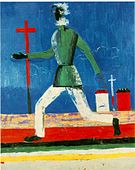|
Kazimir Malevich
Kazimir Severinovich Malevich[nb 1] (23 February [O.S. 11 February] 1879[1] – 15 May 1935) was a Russian avant-garde[nb 2] artist and art theorist, whose pioneering work and writing influenced the development of abstract art in the 20th century.[2][3] He was born in Kiev, modern-day Ukraine, to an ethnic Polish family. His concept of Suprematism sought to develop a form of expression that moved as far as possible from the world of natural forms (objectivity) and subject matter in order to access "the supremacy of pure feeling"[4] and spirituality.[5][6] Active primarily in Russia, Malevich was a founder of the artists collective UNOVIS and his work has been variously associated with the Russian avant-garde and the Ukrainian avant-garde, and he was a central figure in the history of modern art in Central and Eastern Europe more broadly.[7][8] Early on, Malevich worked in a variety of styles, quickly assimilating the movements of Impressionism, Symbolism and Fauvism and, after visiting Paris in 1912, Cubism. Gradually simplifying his style, he developed an approach with key works consisting of pure geometric forms and their relationships to one another, set against minimal grounds. His Black Square (1915), a black square on white, represented the most radically abstract painting known to have been created so far[9] and drew "an uncrossable line (…) between old art and new art";[10] Suprematist Composition: White on White (1918), a barely differentiated off-white square superimposed on an off-white ground, would take his ideal of pure abstraction to its logical conclusion.[11] In addition to his paintings, Malevich laid down his theories in writing, such as "From Cubism and Futurism to Suprematism" (1915)[12] and The Non-Objective World: The Manifesto of Suprematism (1926).[13][14] Malevich's trajectory in many ways mirrored the tumult of the decades surrounding the October Revolution in 1917.[15] In its immediate aftermath, vanguard movements such as Suprematism and Vladimir Tatlin's Constructivism were encouraged by Trotskyite factions in the government. Malevich held several prominent teaching positions and received a solo show at the Sixteenth State Exhibition in Moscow in 1919. His recognition spread to the West with solo exhibitions in Warsaw and Berlin in 1927. From 1928 to 1930, he taught at the Kiev Art Institute, with Alexander Bogomazov, Victor Palmov, Vladimir Tatlin and published his articles in a Kharkiv magazine Nova Generatsiia (New generation).[16] But the start of repression in Ukraine against the intelligentsia forced Malevich return to Leningrad (Saint Petersburg). From the beginning of the 1930s, modern art was falling out of favor with the new government of Joseph Stalin. Malevich soon lost his teaching position, artworks and manuscripts were confiscated, and he was banned from making art.[17][18] In 1930, he was imprisoned for two months due to suspicions raised by his trip to Poland and Germany. Forced to abandon abstraction, he painted in a representational style in the years before his death from cancer in 1935, at the age of 56. His art and his writings influenced contemporaries such as El Lissitzky, Lyubov Popova and Alexander Rodchenko, as well as generations of later abstract artists, such as Ad Reinhardt and the Minimalists. He was celebrated posthumously in major exhibits at the Museum of Modern Art (1936), the Guggenheim Museum (1973) and the Stedelijk Museum in Amsterdam (1989), which has a large collection of his work. In the 1990s, the ownership claims of museums to many Malevich works began to be disputed by his heirs.[18] Early life (1879-1904) Kazimir Malevich[19] was born in 1879 Kazimierz Malewicz to a Polish family,[20][21][22] who settled near Kiev in Kiev Governorate of the Russian Empire during the partitions of Poland.[17] His parents, Ludwika and Seweryn Malewicz, were Roman Catholic like most ethnic Poles,[2] though his father attended Orthodox services as well.[23] His native language was Polish, but he also spoke Russian,[24] as well as Ukrainian due to his childhood surroundings.[25] His mother Ludwika wrote poetry in Polish and sang Polish songs, and kept a record of the Polish families living in the area.[23] Malevich would later write a series of articles in Ukrainian about art, and identified as Ukrainian.[26] Kazimir's father managed a sugar factory. Kazimir was the first of fourteen children,[17] only nine of whom survived into adulthood. His family moved often and he spent most of his childhood in the villages of modern-day Ukraine, amidst sugar-beet plantations, far from centers of culture. Until age twelve, he knew nothing of professional artists, although art had surrounded him in childhood. He delighted in peasant embroidery, and in decorated walls and stoves. He was able to paint in the peasant style. He studied drawing in Kiev from 1895 to 1896. From 1896 to 1904, Kazimir Malevich lived in Kursk, where he encountered several Russian artists, including Lev Kvachevsky, with whom he often worked outdoors.[27]: 5–6 Avant-garde and Moscow (1904-1915)In 1904, recognizing his style as increasingly more Impressionistic, he intended to receive more academic training and moved to Moscow.[27]: 5–6 Between 1905 and 1910, he worked in the studio of Fedor Rerberg in Moscow. Malevich and other artists in Moscow gained an early exposure to Western avant-garde art, particularly to the works of Pablo Picasso and Henri Matisse, through the private collection of Sergei Shchukin.[28][27]: 10 By 1904, as more French art was being reproduced and discussed in Russia in the magazine Mir iskusstva, Malevich had also become acquainted with the work of Paul Gauguin.[29]: 2–4 Symbolism had an impact on Malevich's work during that time, as evident in paintings such as The Triumph of Heaven (1907) and The Shroud of Christ (1908).[29]: 9 In 1911, he participated in the second exhibition of the group, Soyuz Molodyozhi (Union of Youth) in St. Petersburg, together with Vladimir Tatlin and, in 1912, the group held its third exhibition, which included works by Aleksandra Ekster, Tatlin, and others. In the same year, he participated in an exhibition by the collective, Donkey's Tail in Moscow. By that time, his works were influenced by Natalia Goncharova and Mikhail Larionov, Russian avant-garde painters, who were particularly interested in Russian folk art called lubok. Malevich described himself as painting in a "Cubo-Futurist" style in 1912.[30] In March 1913, Malevich participated in the Target exhibition in Moscow together with Goncharova and Larionov, continuing to reinterpret Futurist vocabularies to "suggest movement by breaking cone shapes into almost unrecognizable forms".[27]: 8 Among other paintings, Malevich exhibited Morning in the Country after Snowstorm and Knifegrinder or Principle of Glittering, both made in 1912, at Target for the first time.[27]: 8–9 That same year, the Cubo-Futurist opera, Victory Over the Sun, with Malevich's stage-set, debuts in Saint Petersburg. In 1914, Malevich exhibited his works in the Salon des Indépendants in Paris together with Alexander Archipenko, Sonia Delaunay, Aleksandra Ekster, and Vadim Meller, among others.[citation needed] Malevich also co-illustrated, with Pavel Filonov, Selected Poems with Postscript, 1907–1914 by Velimir Khlebnikov and another work by Khlebnikov in 1914 titled Roar! Gauntlets, 1908–1914, with Vladimir Burliuk.[31][32] Later in that same year, he created a series of lithographs in support of Russia's entry into WWI. These prints, accompanied by captions by Vladimir Mayakovsky and published by the Moscow-based publication house Segodniashnii Lubok (Contemporary Lubok), on the one hand show the influence of traditional folk art, but on the other are characterised by solid blocks of pure colours juxtaposed in compositionally evocative ways that anticipate his Suprematist work.[33] In 1911, Brocard & Co. produced an eau de cologne called Severny. Malevich conceived the advertisement and design of the perfume bottle with craquelure of an iceberg and a polar bear on the top, which lasted through the mid-1920s.[34] Suprematism (1915)In 1915, Malevich laid down the foundations of Suprematism when he published his manifesto, From Cubism to Suprematism. In 1915–1916, he worked with other Suprematist artists in a peasant/artisan co-operative in Skoptsi and Verbovka village. In 1916–1917, he participated in exhibitions of the Jack of Diamonds group in Moscow together with Nathan Altman, David Burliuk, Aleksandra Ekster and others. Famous examples of his Suprematist works include Black Square (1915)[35] and White On White (1918). Malevich exhibited his first Black Square, now at the Tretyakov Gallery in Moscow, at the Last Futurist Exhibition 0,10 in Petrograd (Saint Petersburg) in 1915.[30] A black square placed against the sun appeared for the first time in the 1913 scenic designs for the Futurist opera Victory over the Sun.[30] The second Black Square was painted around 1923. Some believe that the third Black Square (also at the Tretyakov Gallery) was painted in 1929 for Malevich's solo exhibition, because of the poor condition of the 1915 square. One more Black Square, the smallest and probably the last, may have been intended as a diptych together with the Red Square (though of smaller size) for the exhibition Artists of the RSFSR: 15 Years, held in Leningrad (1932). The two squares, Black and Red, were the centerpiece of the show. This last square, despite the author's note 1913 on the reverse, is believed to have been created in the late twenties or early thirties, for there are no earlier mentions of it.[36] While Malevich's ideas and theories behind Suprematism were grounded in a belief in the spiritual and transformative power of art, he saw Suprematism as a way to access a higher, more pure realm of artistic expression and to tap into the spiritual through abstraction. Thus, the overarching philosophy of Suprematism expressed in various manifestos would be that he "transformed himself in the zero of form and dragged himself out of the rubbish-heap of illusion and the pit of naturalism. He destroyed the ring of the horizon and escaped from the circle of objects, moving from the horizon-ring to the circle of spirit".[37] Malevich's student Anna Leporskaya observed that Malevich "neither knew nor understood what the black square contained. He thought it so important an event in his creation that for a whole week he was unable to eat, drink or sleep".[38] In 1918, Malevich decorated a play, Mystery-Bouffe, by Vladimir Mayakovskiy produced by Vsevolod Meyerhold. He was interested in aerial photography and aviation, which led him to abstractions inspired by or derived from aerial landscapes.[39] Painting techniqueAccording to an observation by radiologist and art historian Milda Victurina, one of the features of Kazimir Malevich's painting technique was the layering of paints one on another to get a special kind of colour spots. For example, Malevich used two layers of colour for the red spot—the lower black and the upper red. The light ray going through these colour layers is perceived by the viewer not as red, but with a touch of darkness. This technique of superimposing the two colours allowed experts to identify fakes of Malevich's work, which generally lacked it.[40] Post-revolutionary years (1918-1935) After the October Revolution (1917), Malevich became a member of the Collegium on the Arts of Narkompros, the Commission for the Protection of Monuments and the Museums Commission (all from 1918–1919). He taught at the Vitebsk Practical Art School in Belarus (1919–1922) alongside Marc Chagall,[41] the Leningrad Academy of Arts (1922–1927), the Kiev Art Institute (1928–1930),[42] and the House of the Arts in Leningrad (1930). He wrote the book The World as Non-Objectivity, which was published in Munich in 1926 and translated into English in 1959. In it, he outlines his Suprematist theories. In 1923, Malevich was appointed director of Petrograd State Institute of Artistic Culture, which was forced to close in 1926 after a Communist party newspaper called it "a government-supported monastery" rife with "counterrevolutionary sermonizing and artistic debauchery." The Soviet state was by then heavily promoting an idealized, propagandistic[43] style of art called Socialist Realism—a style Malevich had spent his entire career repudiating. Nevertheless, he swam with the current, and was quietly tolerated by the Communists.[44] In 1927, Malevich traveled to Warsaw where he exhibited his work at the Polish Arts Club housed in the Polonia Hotel.[45]: 248 He met with several Polish artists, including his former students Władysław Strzemiński and Katarzyna Kobro, whose own movement, Unism, was highly influenced by Malevich, and Henryk Stażewski, a prominent artist associated with Polish Constructivist movement.[46] While generally greeted with enthusiasm, Malevich faced criticism from some artists, including Mieczysław Szczuka, who argued that Suprematism, as understood by Malevich, was no longer relevant for Polish utilitarianism-oriented avant-garde and that the artist was "a Romantic who loves painterly means for their own sake".[45]: 247–249 Art historian Matthew Drutt notes that despite these criticisms, Malevich's Warsaw exhibition and the lecture on Suprematism he had delivered during his visit had a lasting effect on Polish modernism.[47]: 19 From there, the painter ventured on to Berlin and Munich for a retrospective which finally brought him international recognition. He arranged to leave most of the paintings behind when he returned to the Soviet Union.[48] Stalinism and censorshipMalevich's assumption that a shifting in the attitudes of the Soviet authorities toward the modernist art movement would take place after the death of Vladimir Lenin and Leon Trotsky's fall from power was proven correct in a couple of years, when the government of Joseph Stalin turned against forms of abstraction, considering them a type of "bourgeois" art, that could not express social realities. As a consequence, many of his works were confiscated and he was banned from creating and exhibiting similar art. In autumn 1930, he was arrested and interrogated by the OGPU in Leningrad, accused of Polish espionage, and threatened with execution. He was released from imprisonment in early December.[25][49] Critics derided Malevich's art as a negation of everything good and pure: love of life and love of nature. The Westernizer artist and art historian Alexandre Benois was one such critic. Malevich responded that art can advance and develop for art's sake alone, saying that "art does not need us, and it never did". Death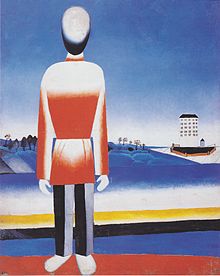 When Malevich died of cancer at the age of fifty-seven, in Leningrad on 15 May 1935, his friends and disciples buried his ashes in a grave marked with a black square. They didn't fulfill his stated wish to have the grave topped with an "architekton"—one of his skyscraper-like maquettes of abstract forms, equipped with a telescope through which visitors were to gaze at Jupiter.[50] On his deathbed, Malevich had been exhibited with the Black Square above him, and mourners at his funeral rally were permitted to wave a banner bearing a black square.[44] Malevich had asked to be buried under an oak tree on the outskirts of Nemchinovka, a place to which he felt a special bond.[51] His ashes were sent to Nemchinovka, and buried in a field near his dacha. Nikolai Suetin, a friend of Malevich's and a fellow artist, designed a white cube with a black square to mark the burial site. The memorial was destroyed during World War II. The city of Leningrad bestowed a pension on Malevich's mother and daughter. In Nazi Germany his works were banned as "Degenerate Art".[48][52][53] In 2013, an apartment block was built on the place of the tomb and burial site of Kazimir Malevich. Another nearby monument to Malevich, put up in 1988, is now also situated on the grounds of a gated community.[51] Nationality and ethnicity Most academic literature and museum collections identify Malevich as a Russian painter, based on his integral role in shaping the Russian avant-garde, centered primarily around Moscow and Petrograd (modern-day St. Petersburg), and the fact that he achieved prominence while living and working in the Russian Empire and later, from 1922 until his death in 1935, the Soviet Union. However, his nationality has been a subject of scholarly dispute.[54][55] PolishMalevich's family was one of the millions of Poles who lived within the Russian Empire following the Partitions of Poland. Kazimir Malevich was born near Kiev[17] on lands that had previously been part of the Polish–Lithuanian Commonwealth[56] of parents who were ethnic Poles.[2] Both Polish and Russian were native languages of Malevich,[57] who would sign his artwork in the Polish form of his name as Kazimierz Malewicz.[58] In a 1926 visa application to travel to France, Malewicz claimed Polish as his nationality.[56] French art historian Andrei Nakov, who re-established Malevich's birth year as 1879 (and not 1878), has argued for restoration of the Polish spelling of Malevich's name.  In 1985, Polish performance artist Zbigniew Warpechowski performed "Citizenship for a Pure Feeling of Kazimierz Malewicz" as an homage to the great artist and critique of Polish authorities that refused to grant Polish citizenship to Kazimir Malevich.[59] In 2013, Malevich's family in New York City and fans founded the not-for-profit The Rectangular Circle of Friends of Kazimierz Malewicz, whose dedicated goal is to promote awareness of Kazimir's Polish ethnicity.[56] UkrainianAccording to Russian scholars Tatiana Mikhienko and Irina Vakar, the secret police file from Malevich's arrest on September 20, 1930 indicates that Malevich declared his nationality as Ukrainian.[25][49] Scholar Marie Gasper-Hulvat notes that this may have been in part motivated by Malevich's desire to avoid anti-Polish discrimination, since Ukraine was at that time part of the Soviet Union.[60] It is sometimes claimed that he self-identified as a Ukrainian throughout his life.[26] Similarly, the French art historian Gilles Néret claimed that Malevich, while at times identifying as Polish "out of tact or mischief" and using the Polish spelling of his name, always emphasized his Ukrainian background.[61]: 7 Following the Russian invasion of Ukraine in 2022 there has been more political and cultural pressure to reconsider his Russian nationality and to identify him instead as Ukrainian painter.[62] This push resulted in the Metropolitan Museum of Art relabeling him as Ukrainian painter, and later Stedelijk Museum labeling him as "Ukrainian painter of Polish origin". The relabeling caused a backlash from Russia, including a statement of the Ministry of Foreign Affairs.[55] However, the consensus among art historians, including those of Ukrainian origin, is that whereas the discussion (related to the Russian colonialism) clearly needs to take place among all involved parties, it has not yet occurred, and the question concerning the identity of Malevich has not been solved as of 2023.[63] Legacy Alfred H. Barr Jr. included several paintings in the groundbreaking exhibition "Cubism and Abstract Art" at the Museum of Modern Art in New York in 1936. In 1939, the Museum of Non-Objective Painting opened in New York, whose founder, Solomon R. Guggenheim—an early and passionate collector of the Russian avant-garde—was inspired by the same aesthetic ideals and spiritual quest that exemplified Malevich's art.[64] The first U.S. retrospective of Malevich's work in 1973 at the Solomon R. Guggenheim Museum provoked a flood of interest and further intensified his impact on postwar American and European artists.[64] However, most of Malevich's work and the story of the Russian avant-garde remained under lock and key until Glasnost.[17] In 1989, the Stedelijk Museum in Amsterdam held the West's first large-scale Malevich retrospective, including the paintings they owned and works from the collection of Russian art critic Nikolai Khardzhiev.[17] CollectionsMalevich's works are held in several major art museums, including the State Tretyakov Gallery in Moscow, and in New York, the Museum of Modern Art[17] and the Guggenheim Museum. The Stedelijk Museum in Amsterdam owns 24 Malevich paintings, more than any other museum outside of Russia.[17] Another major collection of Malevich works is held by the State Museum of Contemporary Art in Thessaloniki.[17] Art market Black Square, the fourth version of his magnum opus painted in the 1920s, was discovered in 1993 in Samara and purchased by Inkombank for US$250,000.[65] In April 2002, the painting was auctioned for an equivalent of US$1 million. The purchase was financed by the Russian philanthropist Vladimir Potanin, who donated funds to the Russian Ministry of Culture,[66] and ultimately, to the State Hermitage Museum collection.[65] According to the Hermitage website, this was the largest private contribution to state art museums since the October Revolution.[66] In 2008, the Stedelijk Museum restituted five works to the heirs of Malevich's family from a group that had been left in Berlin by Malevich, and acquired by the gallery in 1958, in exchange for undisputed title to the remaining pictures.[67] On 3 November 2008, one of these works entitled Suprematist Composition from 1916, set the world record for any Russian work of art and any work sold at auction for that year, selling at Sotheby's in New York City for just over US$60 million (surpassing his previous record of US$17 million set in 2000). In May 2018, the same painting Suprematist Composition 1916 sold at Christie's New York for over US$85 million (including fees), a record auction price for a Russian work of art.[68]  In popular cultureMalevich's life inspires many references featuring events and the paintings as players. The smuggling of Malevich paintings out of Russia is a key to the plot line of writer Martin Cruz Smith's thriller Red Square. Noah Charney's novel, The Art Thief tells the story of two stolen Malevich White on White paintings, and discusses the implications of Malevich's radical Suprematist compositions on the art world. British artist Keith Coventry has used Malevich's paintings to make comments on modernism, in particular his Estate Paintings. Malevich's work also is featured prominently in the Lars von Trier film, Melancholia. At the Closing Ceremony of the 2014 Winter Olympics in Sochi, Malevich visual themes were featured (via projections) in a section on 20th century Russian modern art. Selected works
† Also known as Red Square: Painterly Realism of a Peasant Woman in Two Dimensions. Gallery
AutobiographiesMalevich wrote two biographical essays, a shorter one in 1923–25, and a much longer account in 1933, representing the artist's explanation of his own evolution up to the appearance of suprematism at the 1915 "0–10" exhibition in Petrograd.[69] Both are published in:
Abridged and revised translations are published in:
The 1923–25 autobiography appears in:
The 1933 autobiography appears in:
See alsoFootnotes
References
Bibliography
External linksWikimedia Commons has media related to Kazimir Malevich. Wikiquote has quotations related to Kazimir Malevich.
|
||||||||||||||||||



